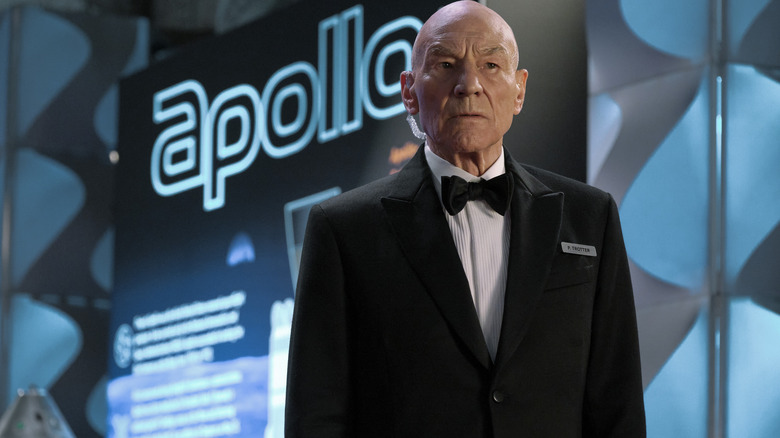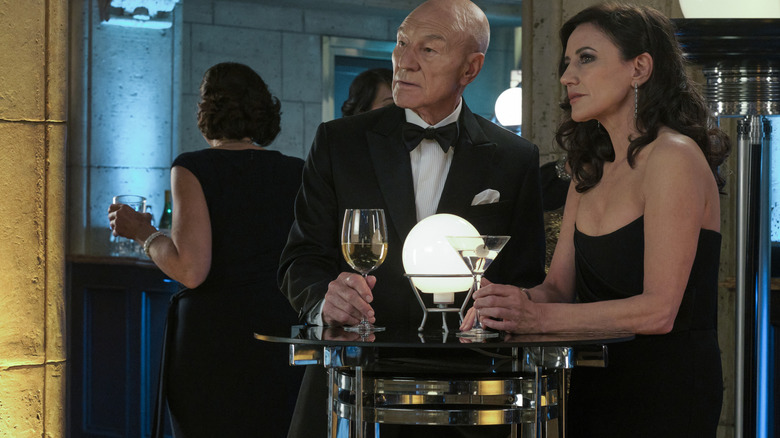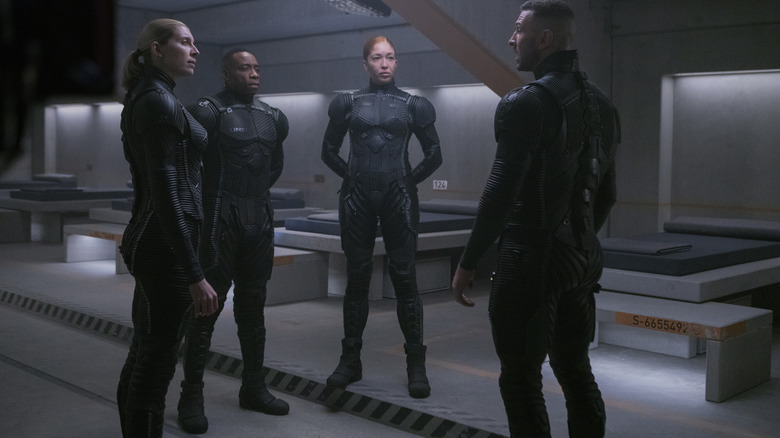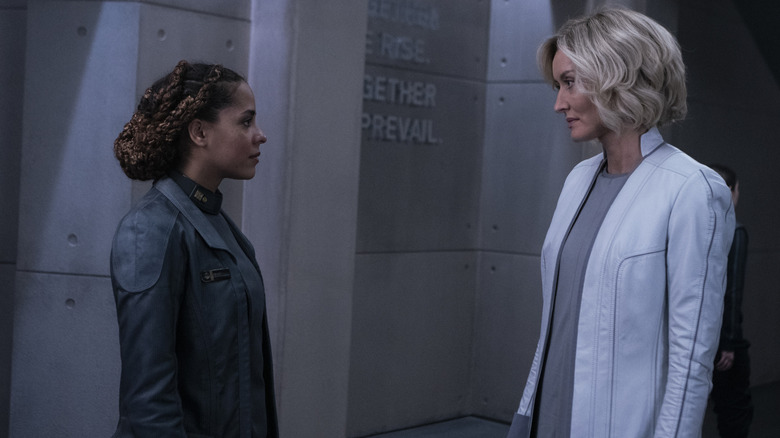Sonic the Hedgehog 2 Producers Believe Jim Carrey Would Return for Part 3 #wanitaxigo



Last week's recap of "Star Trek: Picard" was a lamentation that the series habitually skews away from philosophy and theme and pushes disappointingly headlong into the more pedestrian storytelling fundamentals of plot and action. Not that a thematically lightweight-yet-fascinating plot cannot carry an episode of "Star Trek" — the parallels between this season of "Picard" and the equally plot-forward film "Star Trek IV: The Voyage Home" are myriad — but in so doing, the showrunners have left behind a vital element of "Trek" that has always made it fascinating: It's wrestling with ideas. "Star Trek IV," while lightweight, had the good taste to make extinction and ecology the center of its story. There are lines of dialogue about the moral horror of hunting a species to extinction. Preachy? Perhaps. Effective? Certainly.
Another antecedent to this season of "Picard" is "All Good Things...," the final episode of "Star Trek: The Next Generation." In that episode, the trickster god Q (John De Lanice) caused Capt. Picard (Patrick Stewart) to become unstuck in time à la "Slaughterhouse-Five" and experience his past, his present, and his future alternately. In that episode, Picard discovers a spatial phenomenon that grows larger as it travels backward through time, eventually growing so large that it interrupts the beginning of life on Earth 3.5 billion years ago. Picard also discovers that he was the one who accidentally created the phenomenon in three separate time periods simultaneously. It's clearer when you watch the episode. "All Good Things..." is about reckoning with the unforeseen damage of your actions, and confronting the paradoxes of causality loops. It's a good episode of TV.
Ecology is not at the center of "Star Trek: Picard," nor is a causality loop. Not really. In "Two for One," the sixth episode of the second season, Picard and company have traveled back in time to prevent the flashpoint that would lead to a fascist future. One would think — with "All Good Things..." in mind — that Picard's own temporal tinkering would eventually be the thing to instigate fascism. A fun ironic twist: Picard's own need to help and prevent darkness would be the thing to cause it. That is not the case. It was revealed in last week's "Fly Me to the Moon" and made more explicit in "Two for One," that Q, stripped of his powers, is deliberately sabotaging human history by: A) Posing as a psychiatrist for astronaut Renée Picard (Penelope Mitchell) and convincing her to abandon her space mission, robbing humanity of some vague sense of togetherness, and B) Hiring Adam Soong (Brent Spiner) a progenitor of Data's creator, to assassinate Renée Picard if that doesn't work. No irony. No poetry. No sense of dark inevitability. Just Q doing — essentially — spy stuff. How uninspired.

The bulk of the action in "Two for One" takes place at a fancy dress ball that our protagonists have infiltrated. Capt. Rios (Santiago Cabrera) was freed from ICE by Raffi (Michelle Hurd) and Seven (Jeri Ryan) just in time to join. Raffi points out to Rios that he is glowing, having fallen in love with Dr. Ramirez (Sol Rodriguez). The Watcher (Orla Brady) is along for the ride. Dr. Jurati (Alison Pill), having had her mind infected by the Borg Queen (Annie Wersching), has out-loud conversations with her new mental passenger, and the two vie for dominance of Dr. Jurati's body.
The rules about The Borg have changed aggravatingly frequently. In "NextGen," the Borg would kidnap a victim and put them through a long, complicated surgical process to assimilate them; there were implants to implant and memories to suppress. In "Star Trek: First Contact," it was revealed that a victim could be assimilated after a mere injection of Borg nanotech that would infiltrate their bloodstream. In "Star Trek: Voyager," we learned that one can be assimilated but retain their individuality, given the proper preparation. In "Picard," we see that the Borg Queen cannot merely infiltrate Dr. Jurati's body, but required some sort of psychic bond and the right amount of endorphins. In a truly silly twist, the Borg Queen convinces Dr. Jurati to sing for a crowd, and the endorphins caused by the room's applause are what allows the cyborg to finally assimilate Dr. Jurati. A complicated plot for an evil half-robot supervillain.
Jean-Luc Picard, meanwhile, has to track down Renée — and this is the climactic moment that separates a fascist future from a hopeful one — and have a 30-second conversation with her about how it's okay to be afraid. That fear is a mark of intelligence. So yes, gentle viewers, the notion that will prevent a fascist future was something stated in similar words from "Paw Patrol: The Movie." Picard is Ryder, Renée is Chase, Dr. Jurati is Marshall, and the Borg Queen is Mayor Humdinger.

Picard is successful. It seems that Renée will take to space, inspire this generation to keep moving forward with optimism, and be the catalyst for Roddenberry's future of hope. With four additional episodes in season two, however, an additional crisis must also be addressed. This will come in the form of the above-mentioned Adam Soong, with whom Q has been scheming. Q has not only hired Soong to assassinate Renée, but to tinker with human genes. The Eugenics Wars are a large part of "Star Trek" mythology — Khan was a cryogenically frozen relic of that war — and it seems that Adam Soong may have something to do with starting them.
Soong fails at his assassination attempt, accidentally running over Picard instead. Picard, injured and unconscious, is taken to Dr. Ramirez, who uses a defibrillator to restart his injured heart. There are cracks about how he has had "all the transplants," and the defibrillator shorts out when Dr. Ramirez uses it. This confirms, unfortunately, that Picard is still an android golem living in the same artificial body his consciousness was shunted into at the conclusion of season one. Seven was missing her Borg implants when Q teleported her into the fascist timeline, leading to the natural assumption that every member of the cast was occupying new bodies in an alternate timeline. As such, Picard was presumably now once again flesh and blood. That assumption was incorrect, and Picard is indeed an android. Why Q removed Seven's Borg implants but did not replace Picard's body is ... well, that's one for the philosophers.

Meanwhile, Adam Soong's daughter Kore (Isa Briones, who played multiple androids in the show's first season) has introduced a new, unrelated plot that will undoubtedly have to be addressed in the show's final four episodes. Kore suffers from an unnamed genetic ailment that prevents her from breathing unfiltered air or standing in direct sunlight. She spends most of her time in a posh basement room only occasionally talking to her father. When she goes snooping through Adam's computer, she finds several online articles on how her father was a mad scientist whose wild genetic experiments cost him his livelihood and credibility in the medical community. She also finds a series of her own childhood photos ... that she does not remember taking. It turns out Kore is merely the latest in a string of failed clones that Soong has been creating for, no doubt, nefarious purposes.
Surely, say I, the notion of a mad scientist using shady genetic experimentation would have been cause enough to suspect a fascist future. It appears the Renée plot, the Watcher, etc., were but window-dressing to a more direct plot about Data's great-great-etc.-grandfather deliberately causing a dark timeline. A more interesting confrontation, surely I say again, would have been Picard facing off against a man who looks like an old officer of his, discussing the ethics of genetic manipulation.
"Picard" is overwritten to the point of nonsense. And while I do appreciate the setting, the overall idea for the plot, and some of the characters, I find "Picard" is still merely stumbling along.
Yet to be resolved: Dr. Jurati possessed by the Borg Queen, the flashbacks with Picard's mother, and Adam Soong. I can't say I have much faith in any potentially clever denouement.
Read this next: The 14 Best Sci-Fi Shows On Amazon Prime
The post A 30-Second Pep Talk Prevents Generations of Fascism in Episode 6 of Star Trek: Picard appeared first on /Film.
https://ift.tt/1Ehgvmf Witney Seibold
Every fan has their own specific reasons for what drew them to "Halo" in the first place. For many, the clean and simple gameplay of "Combat Evolved" held plenty of appeal all on its own, rewarding intuitive gamers who swapped guns and employed various strategies depending on the needs of specific situations and level designs. For others, the incredible amount of world-building and lore packed into the story hooked them immediately and would go on to prove foundational — not only to the original game and its many sequels and spin-offs, but to an entire expanded universe of "Halo" tie-in novels, comics, encyclopedias, toys, and more.
For the more romantic and narrative-minded among us, however, one key character dynamic has served as one of the franchise's main selling points throughout the last 2 decades. The unlikely bond between the artificial intelligence Cortana and the super-soldier Master Chief (and, by extension, the gamer/reader/viewer themselves) has slowly but steadily evolved over the course of their adventures into something that defies all labels. Though originally designed as little more than a helpful piece of hardware to guide gamers through labyrinthine locations and provide handy exposition dumps when needed, subsequent material increasingly placed Cortana in a more central role, to the point of providing some of the series' most affecting moments ("Don't make a girl a promise ... if you know you can't keep it") and even forming the emotional backbone of the somewhat divisive "Halo 4."
That brings us to this latest episode of the Paramount+ "Halo" series titled, fittingly, "Emergence." After a first few weeks of dancing around this inevitable introduction, episode 3 finally sees fit to bring the Master Chief (Pablo Schreiber) and Cortana (Jen Taylor, reprising her voice role from the games) together again, although in vastly different circumstances than fans ever could've anticipated.
Overall, this latest hour still feels like yet another mixed bag, with some storylines and creative choices continuing to work better than others. It also feels like the show at its absolute weirdest ... but I'm not entirely sure that's a criticism, mind you. In any case, the shot in the arm provided by this significant plot development should at least provide some much-needed momentum going forward, as we've now put the first third of this inaugural season behind us. Let's break it all down below.

For an episode seemingly all about John-117 and Cortana, it's an interesting decision on the part of showrunners/writers Kyle Killen and Steven Kane and director Roel Reiné ("Black Sails," "Inhumans") to start things off with an unrelated flashback to roughly 2 decades in the past.
It isn't immediately clear what connection the brutal conditions of planet Oban, an industrial waste salvage colony, shares with the ongoing plot ... until the Covenant rudely arrives. The episode is initially content to play things close to the vest, leaving us to focus on two small children hiding from the oppressive Robocop-esque guards who are forcing the planet's populace into grueling working conditions straight out of "Alien 3." We find a young boy named Det (Billy Marlow) reading aloud to his crush from a (fictional) novel titled "The Dawn of Angels" — the same book, viewers may recognize, that was in the possession of the human captive/ally of the Covenant, "the Blessed One" (Charlie Murphy), for the purpose of understanding humanity. Yes, we're watching the young version of this enigmatic character (played by Zazie Hayhurst) and discovering how the Covenant tracked her while seemingly searching for another relic.
The purpose of this prologue, it seems, is to set up one of the more important storylines for the season in the weeks ahead: Makee's mission to infiltrate the humans of the UNSC (a rare glimpse of action and body horror later on as Makee and wormlike Covenant aliens slice through a UNSC ship with terrifying ease), track down the "keystone" artifact (starting in Madrigal), and deliver the Demon's head for the Covenant Prophets. This has remained one of the more frustratingly vague subplots and characters in "Halo" to this point, admittedly, but things finally seem to be kicking into gear.
In fact, this sense of forward motion extends beyond the Covenant side of the story and to the UNSC as well. John continues on his mini-quest of introspection, questioning what remains of his humanity and the mysterious effect the Madrigal object continues to have on him. Elsewhere, however, even someone like Miranda Keyes (Olive Gray) is given an actual plot function, as Admiral Parangosky (Shabana Azmi) tasks the young scientist with leading her own team to analyze the relic, intentionally setting her at odds with her own estranged mother and rendering the upstart Halsey slightly less important to the Admiral in the process. Though all of these characters remain separated in their own oddly confined subplots, it's easy to see how their roles continue to round into shape. The Chief and Makee, in particular, certainly seem destined for a collision course sometime down the line, as well.
But first, let's get to the actual "emergence" of the episode.

With the table-setting out of the way, the weirdness truly begins. Following up on last week's cliffhanger ending with Dr. Halsey's (Natascha McElhone) clone awakening, the latest episode throws us right into the deep end of the uncanny valley. Halsey's early conversation with the sentient and self-aware clone is bizarre, awkward, and off-putting enough to make me want to give this heavily modified Cortana storyline a chance. A brilliant (if wildly unethical) scientist bickering with her fully-formed (and very illegal) flash clone who knows exactly why she's been created — organ harvesting — may not be precisely what anyone expected to see from a "Halo" series, but the results are fascinating nonetheless.
Here, we receive even more evidence of Halsey's coldhearted and ruthless streak: "You are merely a product of [my] samples," she informs the living, breathing being across from her, currently performing advanced intelligence tests. More importantly, this gives us another brief window into the dark beginnings of the Spartan program itself. The Halsey clone bluntly asks about "the children," clearly referring to the Spartan candidates that Dr. Halsey and the UNSC indoctrinated into the super-soldier program at a young age. Upon being informed that only 35 survived the augmentation process, horrifically implying that more than half were killed, the clone immediately realizes that she'll be playing a significant role in the implementation of Cortana — namely, providing the brain for the artificial intelligence. If there were any doubts about the show's viewpoint on the UNSC's moral turpitude, the clone's gruesome death scene that follows not-so-subtly codes Halsey and her creepy assistant Adun (Ryan McParland) as Nazi-era scientists, doing anything in the name of "progress" (Halsey's own words) to justify their means.
In all honesty, kudos to the series creators for taking the uncomfortable subtext of the franchise — the fascistic undertones inherent in the Spartans' origins and continued service — and forcing audiences to confront it face-to-face (literally).
Cortana's "birth" neatly dovetails with the Chief's personal journey into his past as he's cleared to return to duty ... but only on the condition that he integrates with Cortana. This doesn't get off to a smooth start, but at least instances like Cortana unexpectedly crashing the Chief's meeting with the other Spartans provide some of the show's only real attempts at humor thus far. Even better, the grating dynamic between the formal, straight-laced Chief and the energetic naïveté of Cortana feels fun and full of potential conflict. It's a neat beginning to their established relationship and almost feels tempting enough to make us conveniently look past her disturbing origins stemming from the murdered Halsey clone — almost.
In another example of this episode's eccentricities, we're treated to an extended sequence where John cuts the hormone-suppressing pellet from his lower back (providing some equal-opportunity nudity after Charlie Murphy's undressing scene last week, for those who keep track of such things!) and goes out into Reach to experience normal human interactions without any artificial filters. Again, fans may not have expected a "Halo" series to feature the Spartan enjoying a classical music concert, but there's something oddly touching about this whole detour.
The ending promises plenty more action and adventure ahead as John insists on visiting his homeworld, which may or may not harbor a second artifact. But for all the show's stumbles so far, episode 3 of "Halo" shows how strangely entertaining the series can be when it embraces the weird.

Read this next: The 15 Best Anthology TV Series Ranked
The post Halo Episode 3: A Classic Franchise Pairing Finally Emerges In The Oddest Episode Yet appeared first on /Film.
https://ift.tt/3K9m4Ch Jeremy MathaiVikrant Massey is on a roll. He delivered the sleeper hit of 2023, 12th Fail . On February …
Read more
Follow Us